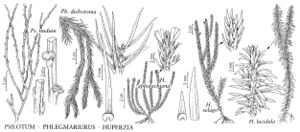Huperzia appalachiana
Amer. Fern J. 82: 42. 1992.
Shoots erect, determinate, 6–10 cm, clustered to rarely shortly decumbent, decumbent portion to 1 cm; leaves in mature distal portion markedly smaller than leaves in juvenile proximal portion; annual constrictions absent; juvenile growth erect. Leaves ascending to spreading (juvenile portion) or ascending to appressed (mature portion), green to yellow green, not lustrous; leaves in juvenile portion narrowly triangular, 4–6 mm, widest at base; leaves in mature portion narrowly triangular, 2–3.5 mm; margins entire or with occasional papillae; stomates present on both surfaces, numerous (35–60 per 1/2 leaf) on adaxial surface. Gemmiferous branchlets produced throughout mature portion; gemmae 3–4 × 2.5–3.5 mm; lateral leaves 0.5–1 mm wide, narrowly acute. Spores 29–35 µm.
Habitat: On damp, acidic, igneous rocks in alpine zone or exposed cliffs and talus slopes elsewhere
Elevation: 800–2300 m, lower (600–1200 m) along coast of Atlantic Ocean and Lake Superior
Distribution

Greenland, St. Pierre and Miquelon, Nfld. and Labr. (Nfld.), N.S., Ont., Que., Ga., Maine, Mass., Mich., Minn., N.H., N.Y., N.C., S.C., Tenn., Vt., Va., possibly Europe
Discussion
Selected References
None.
Lower Taxa
"widest" is not a number.
